Project Management Plan: Warabrook-Maitland Train Line Removal
VerifiedAdded on 2020/11/12
|16
|4197
|142
Project
AI Summary
This project management plan focuses on the removal of the public train line between Warabrook and Maitland, NSW, due to the deteriorating quality of existing tracks and the resulting safety concerns and service disruptions. The plan details the project background, objectives, and scope, including the evaluation of different removal methods and the analysis of associated problems. It outlines key deliverables, requirements, and constraints, such as the need for timely government approvals. The plan also includes a work breakdown structure, budget considerations, and stakeholder management strategies. The Agile construction methodology will be employed, involving iterative reviews and adjustments to ensure efficient project execution. Risk management and schedule management are also addressed, providing a comprehensive framework for successful project completion. The plan aims to provide a detailed roadmap for the project, ensuring all aspects, from initial planning to stakeholder engagement, are thoroughly considered and managed.
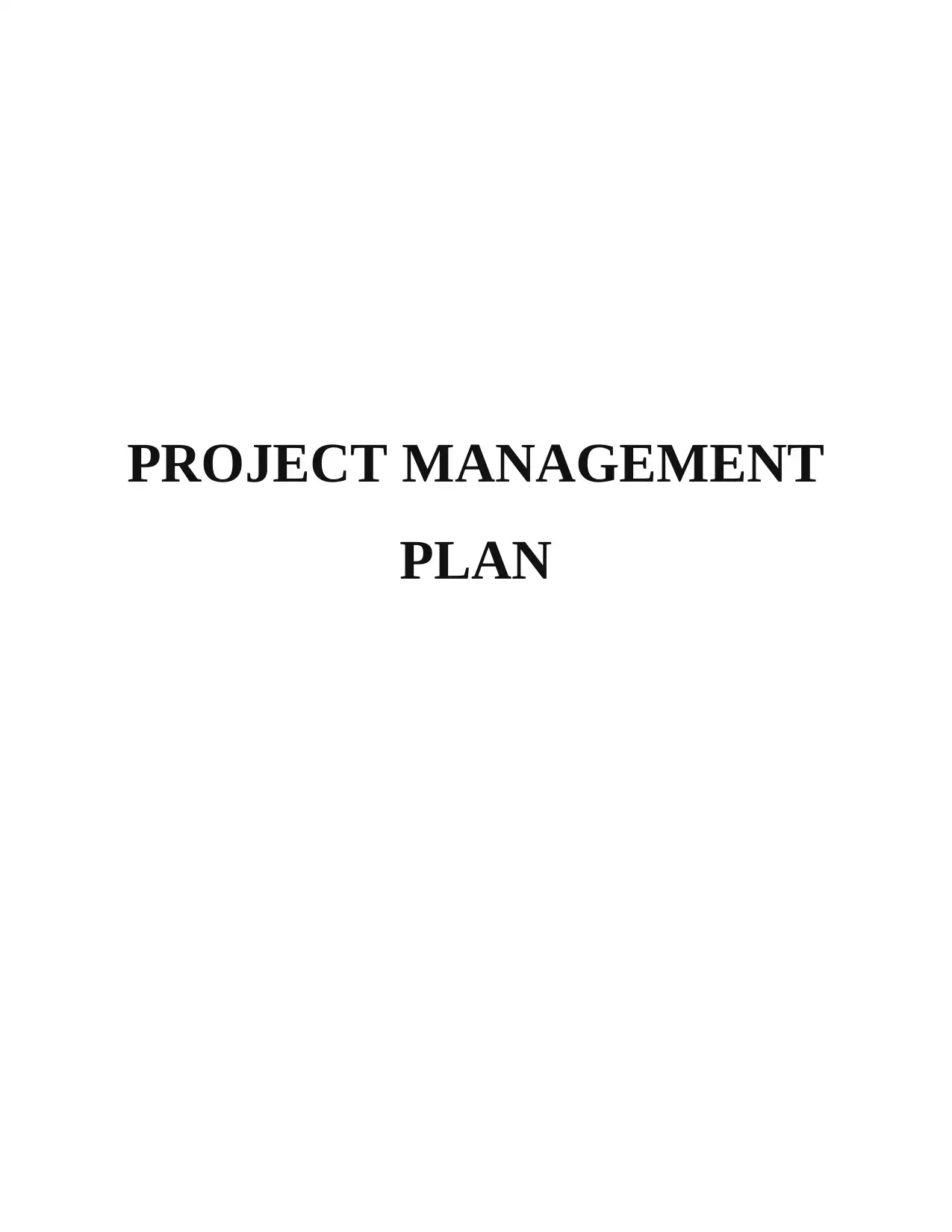
PROJECT MANAGEMENT
PLAN
PLAN
Paraphrase This Document
Need a fresh take? Get an instant paraphrase of this document with our AI Paraphraser
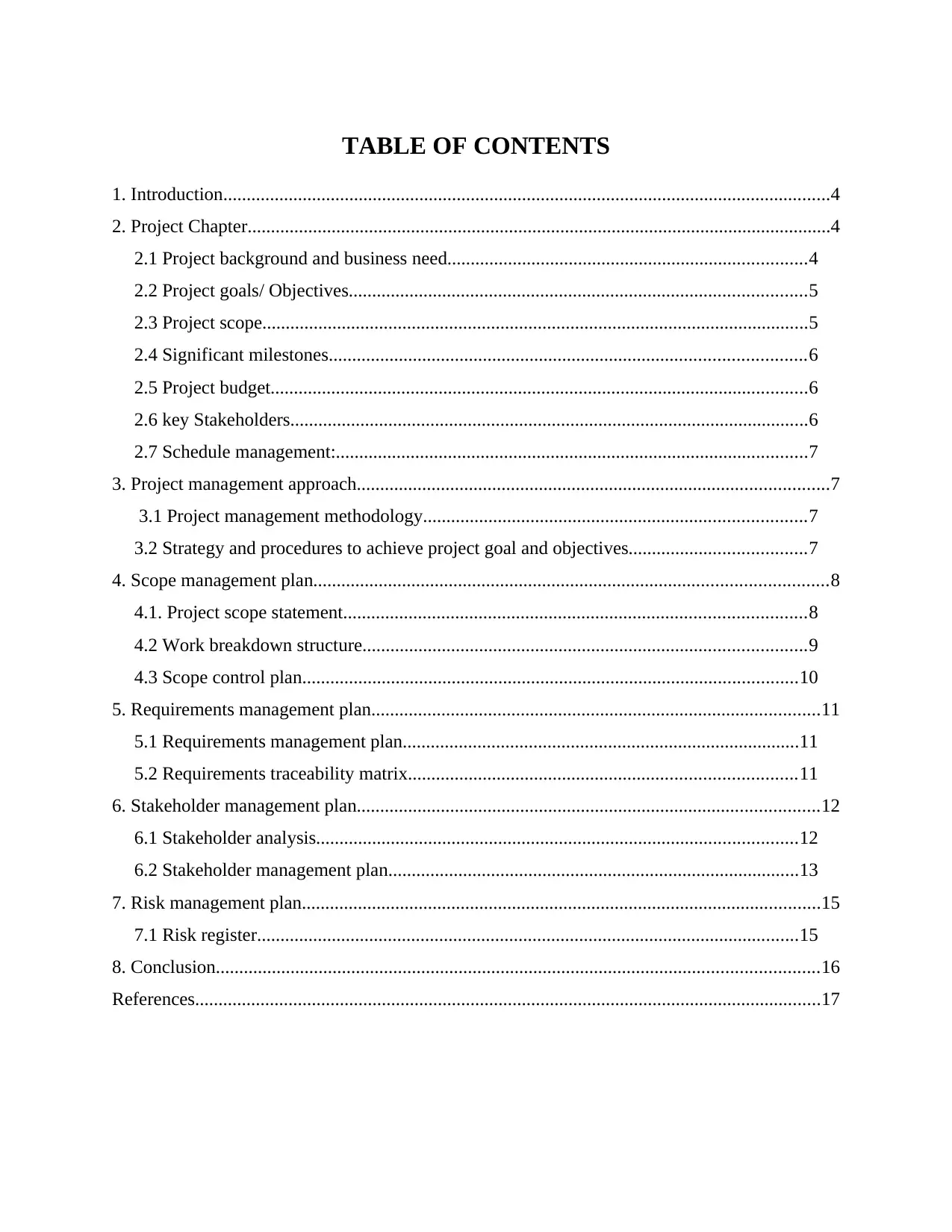
TABLE OF CONTENTS
1. Introduction..................................................................................................................................4
2. Project Chapter.............................................................................................................................4
2.1 Project background and business need.............................................................................4
2.2 Project goals/ Objectives..................................................................................................5
2.3 Project scope.....................................................................................................................5
2.4 Significant milestones......................................................................................................6
2.5 Project budget...................................................................................................................6
2.6 key Stakeholders...............................................................................................................6
2.7 Schedule management:.....................................................................................................7
3. Project management approach.....................................................................................................7
3.1 Project management methodology..................................................................................7
3.2 Strategy and procedures to achieve project goal and objectives......................................7
4. Scope management plan..............................................................................................................8
4.1. Project scope statement...................................................................................................8
4.2 Work breakdown structure...............................................................................................9
4.3 Scope control plan..........................................................................................................10
5. Requirements management plan................................................................................................11
5.1 Requirements management plan.....................................................................................11
5.2 Requirements traceability matrix...................................................................................11
6. Stakeholder management plan...................................................................................................12
6.1 Stakeholder analysis.......................................................................................................12
6.2 Stakeholder management plan........................................................................................13
7. Risk management plan...............................................................................................................15
7.1 Risk register....................................................................................................................15
8. Conclusion.................................................................................................................................16
References......................................................................................................................................17
1. Introduction..................................................................................................................................4
2. Project Chapter.............................................................................................................................4
2.1 Project background and business need.............................................................................4
2.2 Project goals/ Objectives..................................................................................................5
2.3 Project scope.....................................................................................................................5
2.4 Significant milestones......................................................................................................6
2.5 Project budget...................................................................................................................6
2.6 key Stakeholders...............................................................................................................6
2.7 Schedule management:.....................................................................................................7
3. Project management approach.....................................................................................................7
3.1 Project management methodology..................................................................................7
3.2 Strategy and procedures to achieve project goal and objectives......................................7
4. Scope management plan..............................................................................................................8
4.1. Project scope statement...................................................................................................8
4.2 Work breakdown structure...............................................................................................9
4.3 Scope control plan..........................................................................................................10
5. Requirements management plan................................................................................................11
5.1 Requirements management plan.....................................................................................11
5.2 Requirements traceability matrix...................................................................................11
6. Stakeholder management plan...................................................................................................12
6.1 Stakeholder analysis.......................................................................................................12
6.2 Stakeholder management plan........................................................................................13
7. Risk management plan...............................................................................................................15
7.1 Risk register....................................................................................................................15
8. Conclusion.................................................................................................................................16
References......................................................................................................................................17
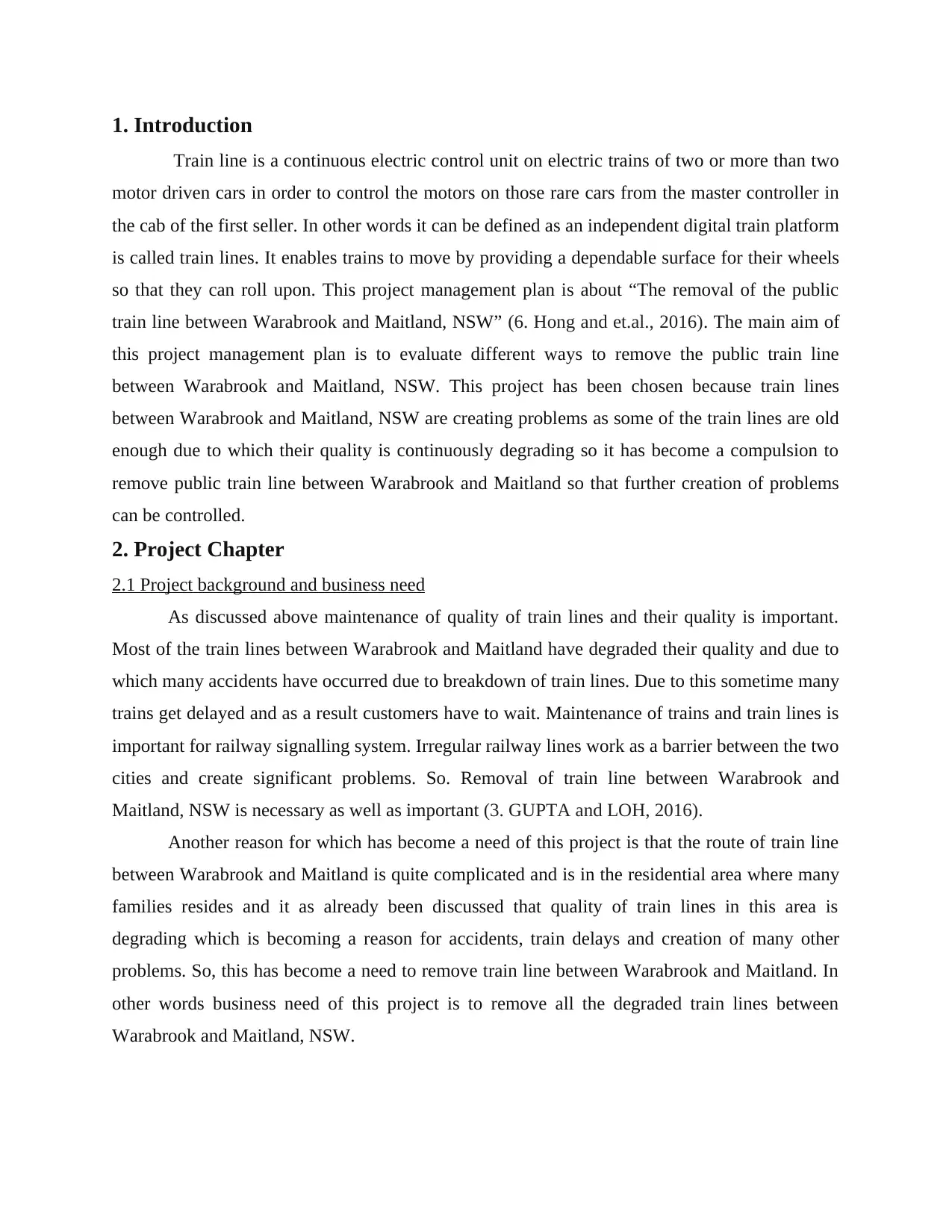
1. Introduction
Train line is a continuous electric control unit on electric trains of two or more than two
motor driven cars in order to control the motors on those rare cars from the master controller in
the cab of the first seller. In other words it can be defined as an independent digital train platform
is called train lines. It enables trains to move by providing a dependable surface for their wheels
so that they can roll upon. This project management plan is about “The removal of the public
train line between Warabrook and Maitland, NSW” (6. Hong and et.al., 2016). The main aim of
this project management plan is to evaluate different ways to remove the public train line
between Warabrook and Maitland, NSW. This project has been chosen because train lines
between Warabrook and Maitland, NSW are creating problems as some of the train lines are old
enough due to which their quality is continuously degrading so it has become a compulsion to
remove public train line between Warabrook and Maitland so that further creation of problems
can be controlled.
2. Project Chapter
2.1 Project background and business need
As discussed above maintenance of quality of train lines and their quality is important.
Most of the train lines between Warabrook and Maitland have degraded their quality and due to
which many accidents have occurred due to breakdown of train lines. Due to this sometime many
trains get delayed and as a result customers have to wait. Maintenance of trains and train lines is
important for railway signalling system. Irregular railway lines work as a barrier between the two
cities and create significant problems. So. Removal of train line between Warabrook and
Maitland, NSW is necessary as well as important (3. GUPTA and LOH, 2016).
Another reason for which has become a need of this project is that the route of train line
between Warabrook and Maitland is quite complicated and is in the residential area where many
families resides and it as already been discussed that quality of train lines in this area is
degrading which is becoming a reason for accidents, train delays and creation of many other
problems. So, this has become a need to remove train line between Warabrook and Maitland. In
other words business need of this project is to remove all the degraded train lines between
Warabrook and Maitland, NSW.
Train line is a continuous electric control unit on electric trains of two or more than two
motor driven cars in order to control the motors on those rare cars from the master controller in
the cab of the first seller. In other words it can be defined as an independent digital train platform
is called train lines. It enables trains to move by providing a dependable surface for their wheels
so that they can roll upon. This project management plan is about “The removal of the public
train line between Warabrook and Maitland, NSW” (6. Hong and et.al., 2016). The main aim of
this project management plan is to evaluate different ways to remove the public train line
between Warabrook and Maitland, NSW. This project has been chosen because train lines
between Warabrook and Maitland, NSW are creating problems as some of the train lines are old
enough due to which their quality is continuously degrading so it has become a compulsion to
remove public train line between Warabrook and Maitland so that further creation of problems
can be controlled.
2. Project Chapter
2.1 Project background and business need
As discussed above maintenance of quality of train lines and their quality is important.
Most of the train lines between Warabrook and Maitland have degraded their quality and due to
which many accidents have occurred due to breakdown of train lines. Due to this sometime many
trains get delayed and as a result customers have to wait. Maintenance of trains and train lines is
important for railway signalling system. Irregular railway lines work as a barrier between the two
cities and create significant problems. So. Removal of train line between Warabrook and
Maitland, NSW is necessary as well as important (3. GUPTA and LOH, 2016).
Another reason for which has become a need of this project is that the route of train line
between Warabrook and Maitland is quite complicated and is in the residential area where many
families resides and it as already been discussed that quality of train lines in this area is
degrading which is becoming a reason for accidents, train delays and creation of many other
problems. So, this has become a need to remove train line between Warabrook and Maitland. In
other words business need of this project is to remove all the degraded train lines between
Warabrook and Maitland, NSW.
⊘ This is a preview!⊘
Do you want full access?
Subscribe today to unlock all pages.

Trusted by 1+ million students worldwide
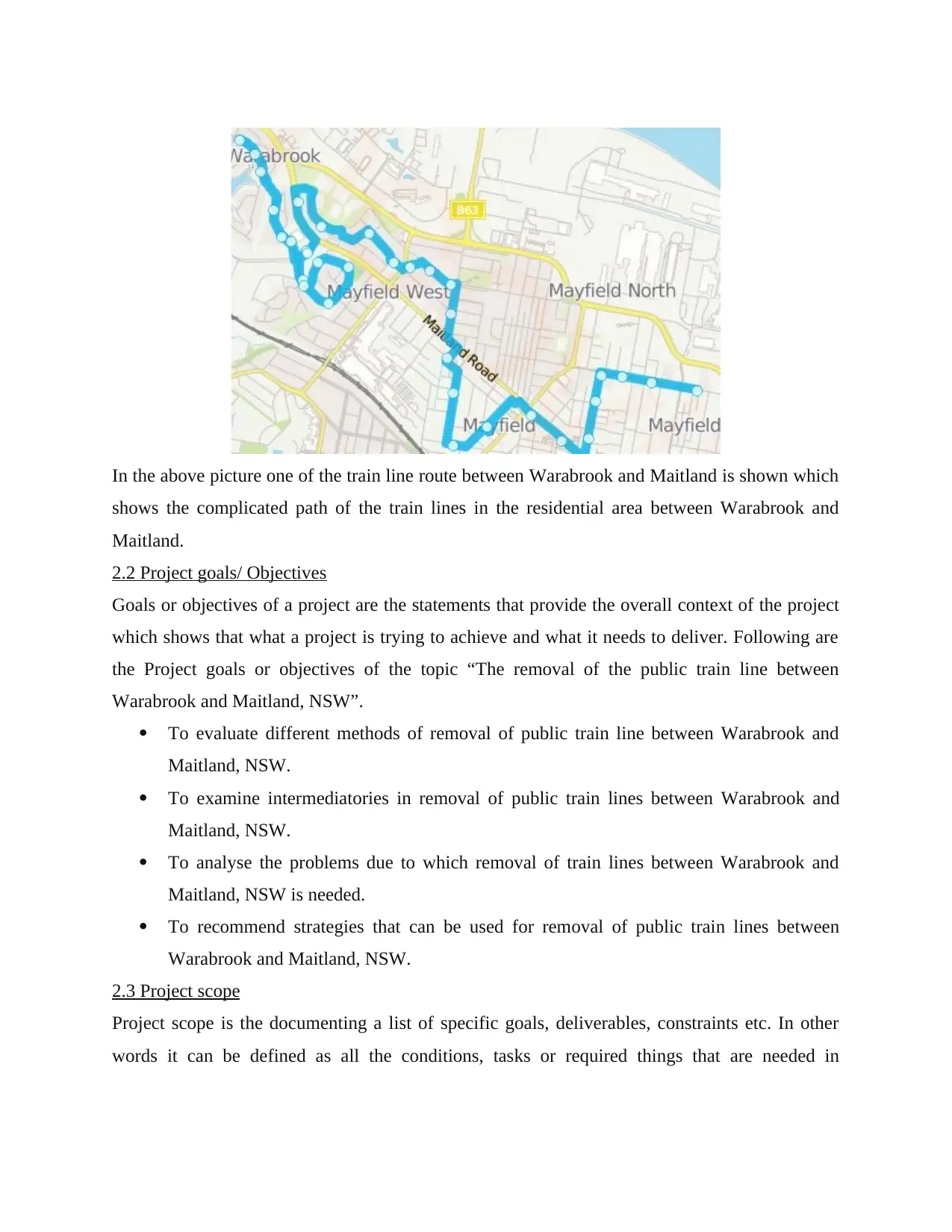
In the above picture one of the train line route between Warabrook and Maitland is shown which
shows the complicated path of the train lines in the residential area between Warabrook and
Maitland.
2.2 Project goals/ Objectives
Goals or objectives of a project are the statements that provide the overall context of the project
which shows that what a project is trying to achieve and what it needs to deliver. Following are
the Project goals or objectives of the topic “The removal of the public train line between
Warabrook and Maitland, NSW”.
To evaluate different methods of removal of public train line between Warabrook and
Maitland, NSW.
To examine intermediatories in removal of public train lines between Warabrook and
Maitland, NSW.
To analyse the problems due to which removal of train lines between Warabrook and
Maitland, NSW is needed.
To recommend strategies that can be used for removal of public train lines between
Warabrook and Maitland, NSW.
2.3 Project scope
Project scope is the documenting a list of specific goals, deliverables, constraints etc. In other
words it can be defined as all the conditions, tasks or required things that are needed in
shows the complicated path of the train lines in the residential area between Warabrook and
Maitland.
2.2 Project goals/ Objectives
Goals or objectives of a project are the statements that provide the overall context of the project
which shows that what a project is trying to achieve and what it needs to deliver. Following are
the Project goals or objectives of the topic “The removal of the public train line between
Warabrook and Maitland, NSW”.
To evaluate different methods of removal of public train line between Warabrook and
Maitland, NSW.
To examine intermediatories in removal of public train lines between Warabrook and
Maitland, NSW.
To analyse the problems due to which removal of train lines between Warabrook and
Maitland, NSW is needed.
To recommend strategies that can be used for removal of public train lines between
Warabrook and Maitland, NSW.
2.3 Project scope
Project scope is the documenting a list of specific goals, deliverables, constraints etc. In other
words it can be defined as all the conditions, tasks or required things that are needed in
Paraphrase This Document
Need a fresh take? Get an instant paraphrase of this document with our AI Paraphraser
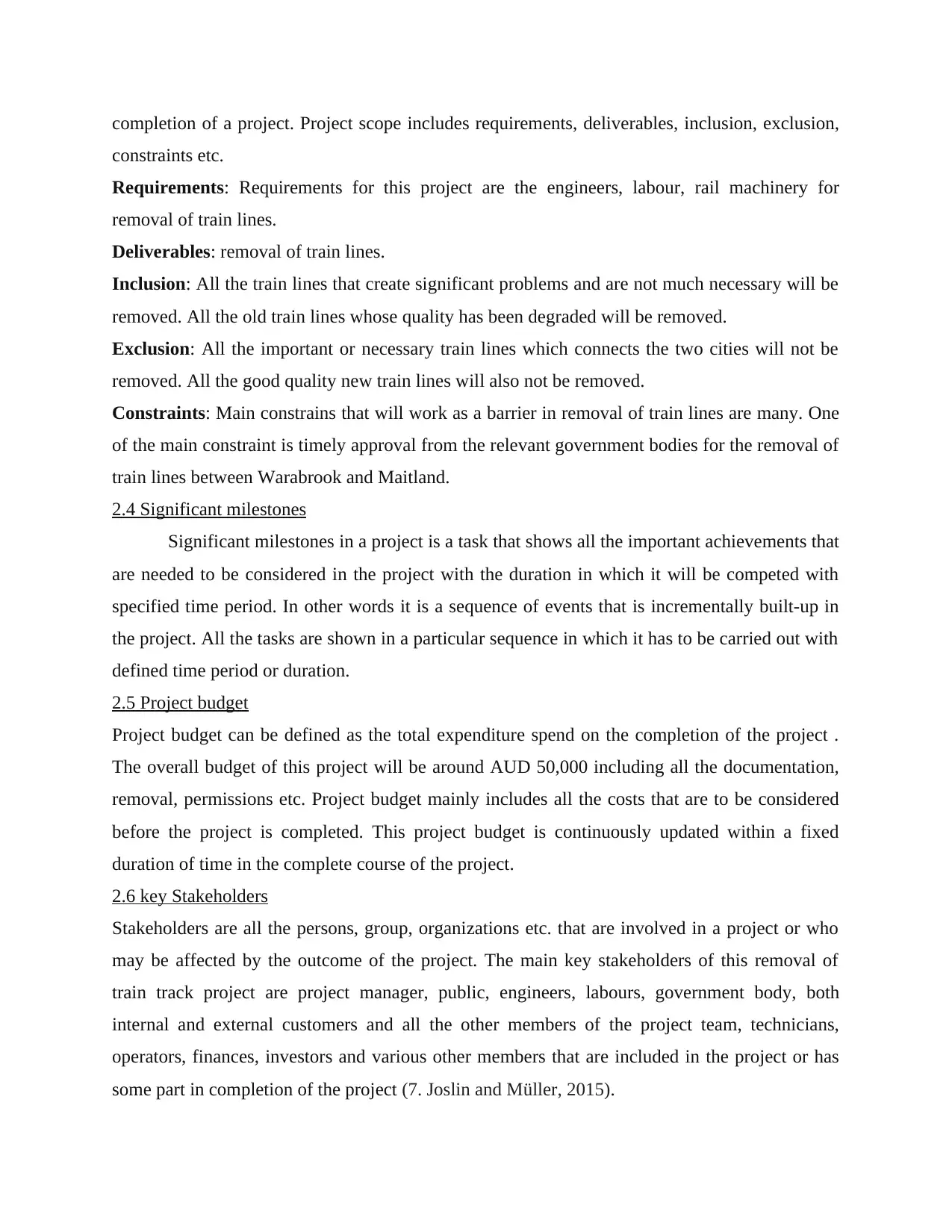
completion of a project. Project scope includes requirements, deliverables, inclusion, exclusion,
constraints etc.
Requirements: Requirements for this project are the engineers, labour, rail machinery for
removal of train lines.
Deliverables: removal of train lines.
Inclusion: All the train lines that create significant problems and are not much necessary will be
removed. All the old train lines whose quality has been degraded will be removed.
Exclusion: All the important or necessary train lines which connects the two cities will not be
removed. All the good quality new train lines will also not be removed.
Constraints: Main constrains that will work as a barrier in removal of train lines are many. One
of the main constraint is timely approval from the relevant government bodies for the removal of
train lines between Warabrook and Maitland.
2.4 Significant milestones
Significant milestones in a project is a task that shows all the important achievements that
are needed to be considered in the project with the duration in which it will be competed with
specified time period. In other words it is a sequence of events that is incrementally built-up in
the project. All the tasks are shown in a particular sequence in which it has to be carried out with
defined time period or duration.
2.5 Project budget
Project budget can be defined as the total expenditure spend on the completion of the project .
The overall budget of this project will be around AUD 50,000 including all the documentation,
removal, permissions etc. Project budget mainly includes all the costs that are to be considered
before the project is completed. This project budget is continuously updated within a fixed
duration of time in the complete course of the project.
2.6 key Stakeholders
Stakeholders are all the persons, group, organizations etc. that are involved in a project or who
may be affected by the outcome of the project. The main key stakeholders of this removal of
train track project are project manager, public, engineers, labours, government body, both
internal and external customers and all the other members of the project team, technicians,
operators, finances, investors and various other members that are included in the project or has
some part in completion of the project (7. Joslin and Müller, 2015).
constraints etc.
Requirements: Requirements for this project are the engineers, labour, rail machinery for
removal of train lines.
Deliverables: removal of train lines.
Inclusion: All the train lines that create significant problems and are not much necessary will be
removed. All the old train lines whose quality has been degraded will be removed.
Exclusion: All the important or necessary train lines which connects the two cities will not be
removed. All the good quality new train lines will also not be removed.
Constraints: Main constrains that will work as a barrier in removal of train lines are many. One
of the main constraint is timely approval from the relevant government bodies for the removal of
train lines between Warabrook and Maitland.
2.4 Significant milestones
Significant milestones in a project is a task that shows all the important achievements that
are needed to be considered in the project with the duration in which it will be competed with
specified time period. In other words it is a sequence of events that is incrementally built-up in
the project. All the tasks are shown in a particular sequence in which it has to be carried out with
defined time period or duration.
2.5 Project budget
Project budget can be defined as the total expenditure spend on the completion of the project .
The overall budget of this project will be around AUD 50,000 including all the documentation,
removal, permissions etc. Project budget mainly includes all the costs that are to be considered
before the project is completed. This project budget is continuously updated within a fixed
duration of time in the complete course of the project.
2.6 key Stakeholders
Stakeholders are all the persons, group, organizations etc. that are involved in a project or who
may be affected by the outcome of the project. The main key stakeholders of this removal of
train track project are project manager, public, engineers, labours, government body, both
internal and external customers and all the other members of the project team, technicians,
operators, finances, investors and various other members that are included in the project or has
some part in completion of the project (7. Joslin and Müller, 2015).
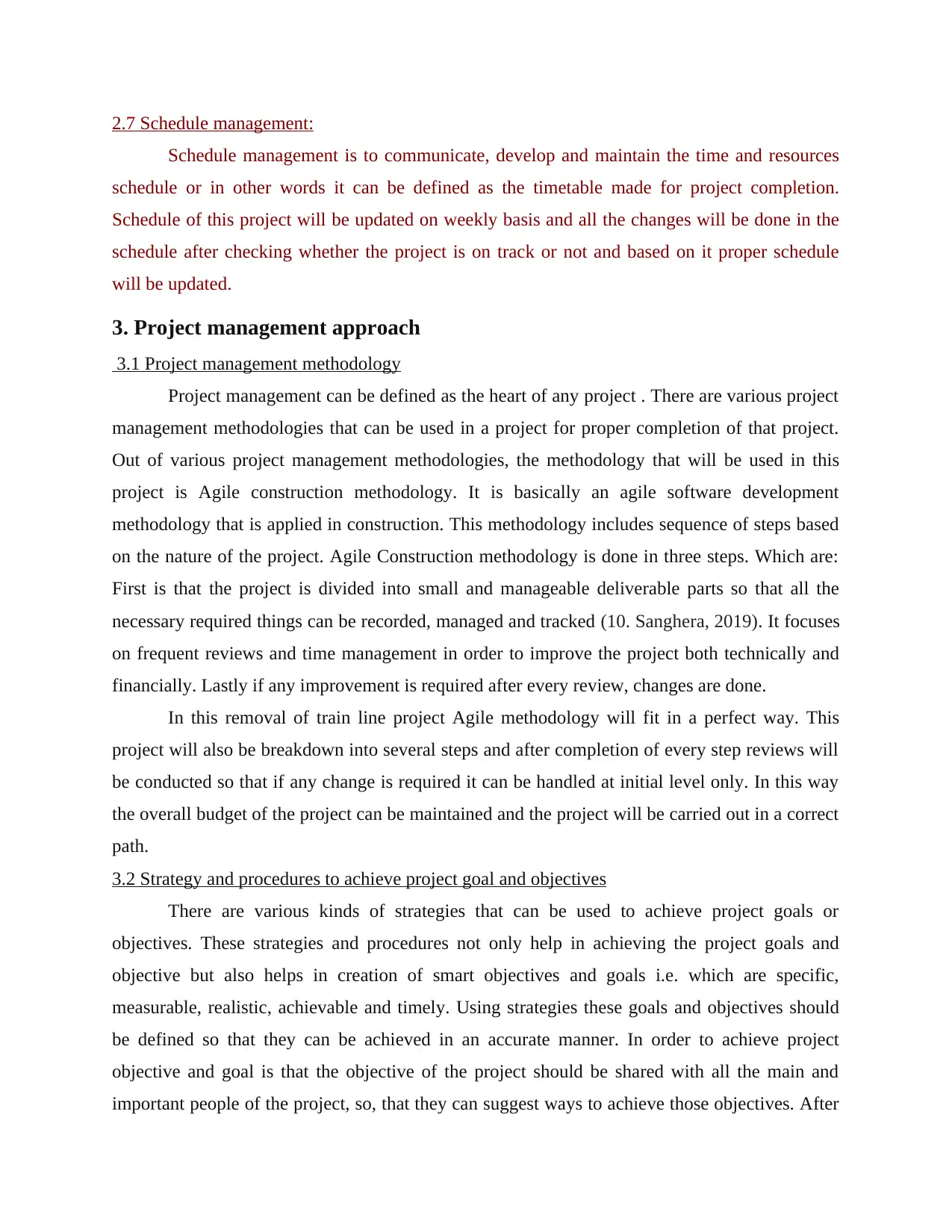
2.7 Schedule management:
Schedule management is to communicate, develop and maintain the time and resources
schedule or in other words it can be defined as the timetable made for project completion.
Schedule of this project will be updated on weekly basis and all the changes will be done in the
schedule after checking whether the project is on track or not and based on it proper schedule
will be updated.
3. Project management approach
3.1 Project management methodology
Project management can be defined as the heart of any project . There are various project
management methodologies that can be used in a project for proper completion of that project.
Out of various project management methodologies, the methodology that will be used in this
project is Agile construction methodology. It is basically an agile software development
methodology that is applied in construction. This methodology includes sequence of steps based
on the nature of the project. Agile Construction methodology is done in three steps. Which are:
First is that the project is divided into small and manageable deliverable parts so that all the
necessary required things can be recorded, managed and tracked (10. Sanghera, 2019). It focuses
on frequent reviews and time management in order to improve the project both technically and
financially. Lastly if any improvement is required after every review, changes are done.
In this removal of train line project Agile methodology will fit in a perfect way. This
project will also be breakdown into several steps and after completion of every step reviews will
be conducted so that if any change is required it can be handled at initial level only. In this way
the overall budget of the project can be maintained and the project will be carried out in a correct
path.
3.2 Strategy and procedures to achieve project goal and objectives
There are various kinds of strategies that can be used to achieve project goals or
objectives. These strategies and procedures not only help in achieving the project goals and
objective but also helps in creation of smart objectives and goals i.e. which are specific,
measurable, realistic, achievable and timely. Using strategies these goals and objectives should
be defined so that they can be achieved in an accurate manner. In order to achieve project
objective and goal is that the objective of the project should be shared with all the main and
important people of the project, so, that they can suggest ways to achieve those objectives. After
Schedule management is to communicate, develop and maintain the time and resources
schedule or in other words it can be defined as the timetable made for project completion.
Schedule of this project will be updated on weekly basis and all the changes will be done in the
schedule after checking whether the project is on track or not and based on it proper schedule
will be updated.
3. Project management approach
3.1 Project management methodology
Project management can be defined as the heart of any project . There are various project
management methodologies that can be used in a project for proper completion of that project.
Out of various project management methodologies, the methodology that will be used in this
project is Agile construction methodology. It is basically an agile software development
methodology that is applied in construction. This methodology includes sequence of steps based
on the nature of the project. Agile Construction methodology is done in three steps. Which are:
First is that the project is divided into small and manageable deliverable parts so that all the
necessary required things can be recorded, managed and tracked (10. Sanghera, 2019). It focuses
on frequent reviews and time management in order to improve the project both technically and
financially. Lastly if any improvement is required after every review, changes are done.
In this removal of train line project Agile methodology will fit in a perfect way. This
project will also be breakdown into several steps and after completion of every step reviews will
be conducted so that if any change is required it can be handled at initial level only. In this way
the overall budget of the project can be maintained and the project will be carried out in a correct
path.
3.2 Strategy and procedures to achieve project goal and objectives
There are various kinds of strategies that can be used to achieve project goals or
objectives. These strategies and procedures not only help in achieving the project goals and
objective but also helps in creation of smart objectives and goals i.e. which are specific,
measurable, realistic, achievable and timely. Using strategies these goals and objectives should
be defined so that they can be achieved in an accurate manner. In order to achieve project
objective and goal is that the objective of the project should be shared with all the main and
important people of the project, so, that they can suggest ways to achieve those objectives. After
⊘ This is a preview!⊘
Do you want full access?
Subscribe today to unlock all pages.

Trusted by 1+ million students worldwide
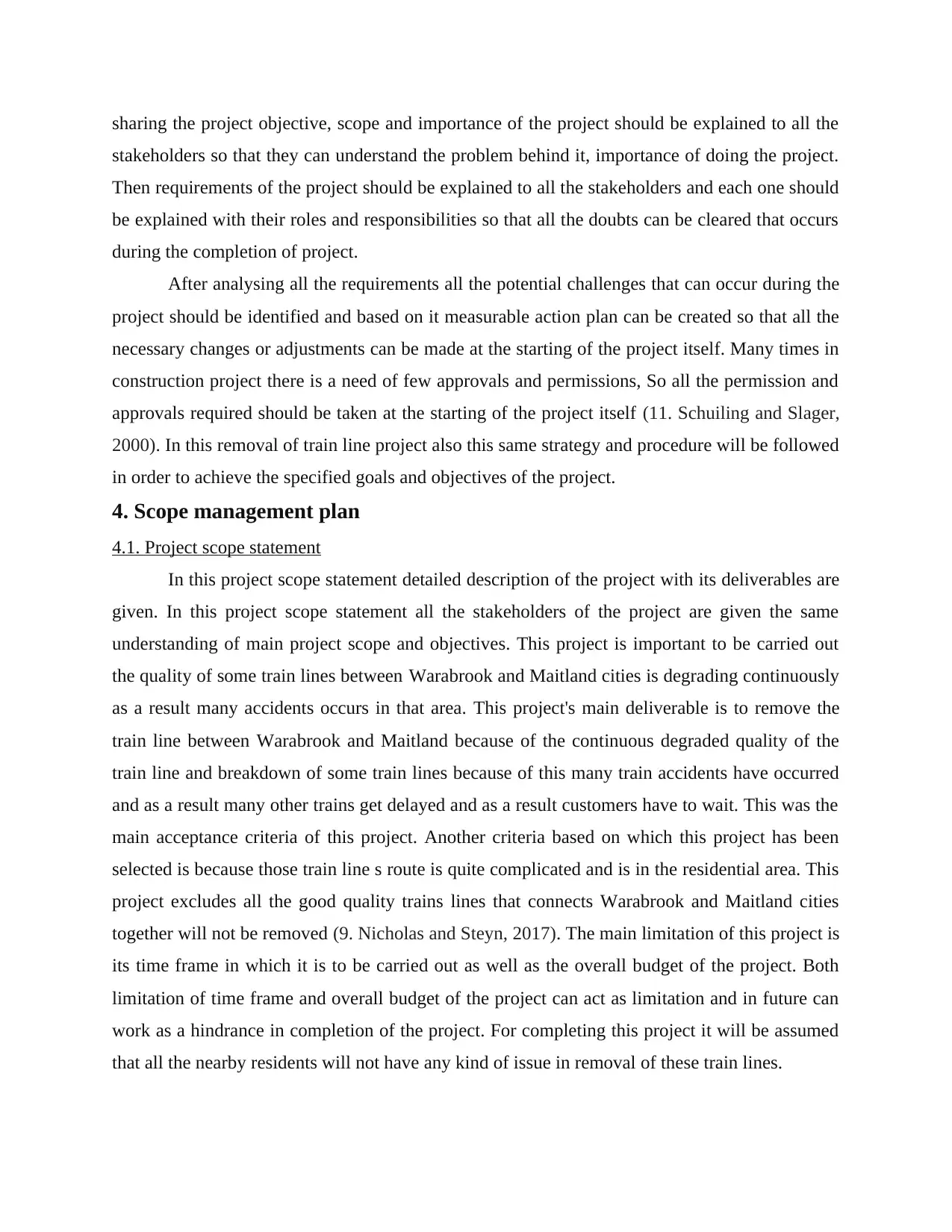
sharing the project objective, scope and importance of the project should be explained to all the
stakeholders so that they can understand the problem behind it, importance of doing the project.
Then requirements of the project should be explained to all the stakeholders and each one should
be explained with their roles and responsibilities so that all the doubts can be cleared that occurs
during the completion of project.
After analysing all the requirements all the potential challenges that can occur during the
project should be identified and based on it measurable action plan can be created so that all the
necessary changes or adjustments can be made at the starting of the project itself. Many times in
construction project there is a need of few approvals and permissions, So all the permission and
approvals required should be taken at the starting of the project itself (11. Schuiling and Slager,
2000). In this removal of train line project also this same strategy and procedure will be followed
in order to achieve the specified goals and objectives of the project.
4. Scope management plan
4.1. Project scope statement
In this project scope statement detailed description of the project with its deliverables are
given. In this project scope statement all the stakeholders of the project are given the same
understanding of main project scope and objectives. This project is important to be carried out
the quality of some train lines between Warabrook and Maitland cities is degrading continuously
as a result many accidents occurs in that area. This project's main deliverable is to remove the
train line between Warabrook and Maitland because of the continuous degraded quality of the
train line and breakdown of some train lines because of this many train accidents have occurred
and as a result many other trains get delayed and as a result customers have to wait. This was the
main acceptance criteria of this project. Another criteria based on which this project has been
selected is because those train line s route is quite complicated and is in the residential area. This
project excludes all the good quality trains lines that connects Warabrook and Maitland cities
together will not be removed (9. Nicholas and Steyn, 2017). The main limitation of this project is
its time frame in which it is to be carried out as well as the overall budget of the project. Both
limitation of time frame and overall budget of the project can act as limitation and in future can
work as a hindrance in completion of the project. For completing this project it will be assumed
that all the nearby residents will not have any kind of issue in removal of these train lines.
stakeholders so that they can understand the problem behind it, importance of doing the project.
Then requirements of the project should be explained to all the stakeholders and each one should
be explained with their roles and responsibilities so that all the doubts can be cleared that occurs
during the completion of project.
After analysing all the requirements all the potential challenges that can occur during the
project should be identified and based on it measurable action plan can be created so that all the
necessary changes or adjustments can be made at the starting of the project itself. Many times in
construction project there is a need of few approvals and permissions, So all the permission and
approvals required should be taken at the starting of the project itself (11. Schuiling and Slager,
2000). In this removal of train line project also this same strategy and procedure will be followed
in order to achieve the specified goals and objectives of the project.
4. Scope management plan
4.1. Project scope statement
In this project scope statement detailed description of the project with its deliverables are
given. In this project scope statement all the stakeholders of the project are given the same
understanding of main project scope and objectives. This project is important to be carried out
the quality of some train lines between Warabrook and Maitland cities is degrading continuously
as a result many accidents occurs in that area. This project's main deliverable is to remove the
train line between Warabrook and Maitland because of the continuous degraded quality of the
train line and breakdown of some train lines because of this many train accidents have occurred
and as a result many other trains get delayed and as a result customers have to wait. This was the
main acceptance criteria of this project. Another criteria based on which this project has been
selected is because those train line s route is quite complicated and is in the residential area. This
project excludes all the good quality trains lines that connects Warabrook and Maitland cities
together will not be removed (9. Nicholas and Steyn, 2017). The main limitation of this project is
its time frame in which it is to be carried out as well as the overall budget of the project. Both
limitation of time frame and overall budget of the project can act as limitation and in future can
work as a hindrance in completion of the project. For completing this project it will be assumed
that all the nearby residents will not have any kind of issue in removal of these train lines.
Paraphrase This Document
Need a fresh take? Get an instant paraphrase of this document with our AI Paraphraser
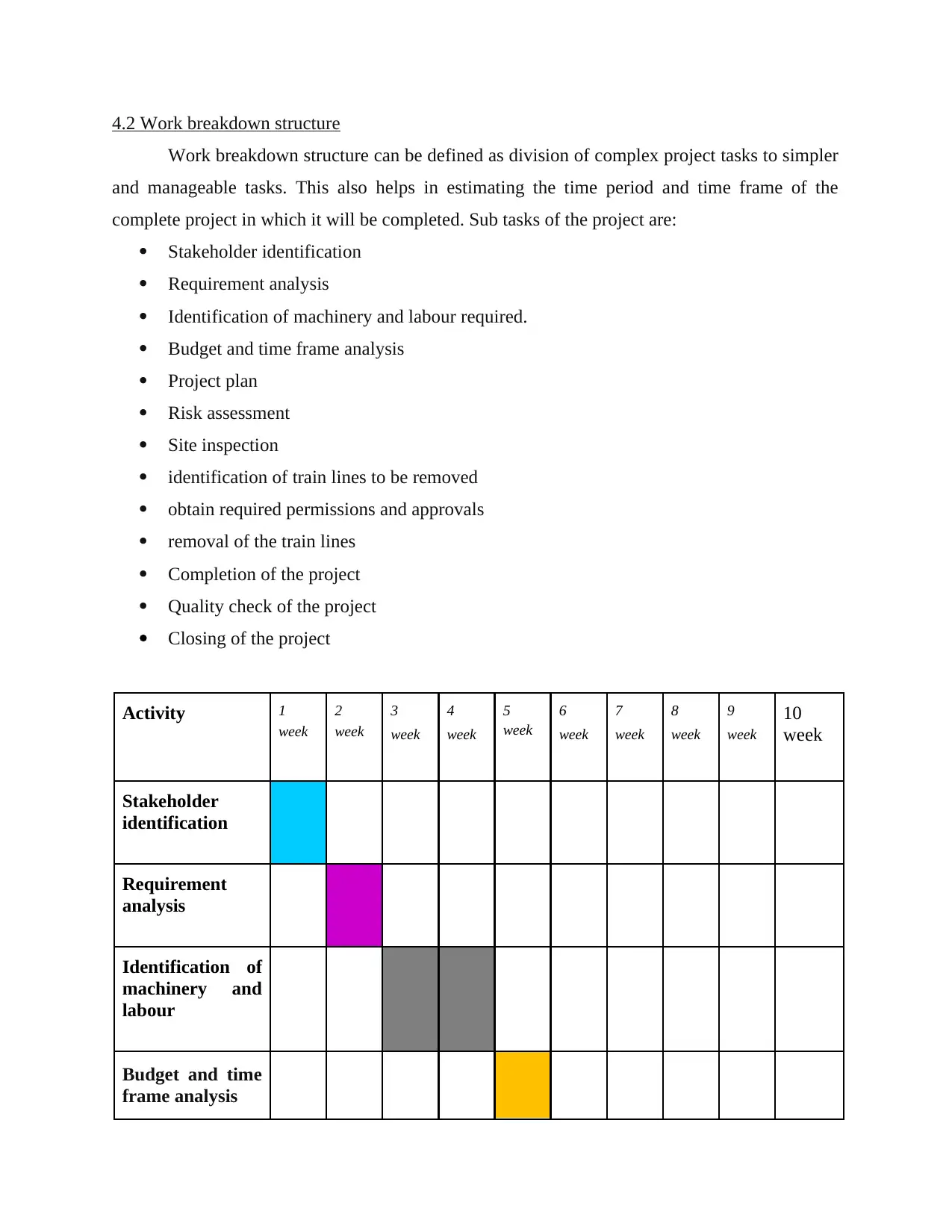
4.2 Work breakdown structure
Work breakdown structure can be defined as division of complex project tasks to simpler
and manageable tasks. This also helps in estimating the time period and time frame of the
complete project in which it will be completed. Sub tasks of the project are:
Stakeholder identification
Requirement analysis
Identification of machinery and labour required.
Budget and time frame analysis
Project plan
Risk assessment
Site inspection
identification of train lines to be removed
obtain required permissions and approvals
removal of the train lines
Completion of the project
Quality check of the project
Closing of the project
Activity 1
week
2
week
3
week
4
week
5
week
6
week
7
week
8
week
9
week
10
week
Stakeholder
identification
Requirement
analysis
Identification of
machinery and
labour
Budget and time
frame analysis
Work breakdown structure can be defined as division of complex project tasks to simpler
and manageable tasks. This also helps in estimating the time period and time frame of the
complete project in which it will be completed. Sub tasks of the project are:
Stakeholder identification
Requirement analysis
Identification of machinery and labour required.
Budget and time frame analysis
Project plan
Risk assessment
Site inspection
identification of train lines to be removed
obtain required permissions and approvals
removal of the train lines
Completion of the project
Quality check of the project
Closing of the project
Activity 1
week
2
week
3
week
4
week
5
week
6
week
7
week
8
week
9
week
10
week
Stakeholder
identification
Requirement
analysis
Identification of
machinery and
labour
Budget and time
frame analysis
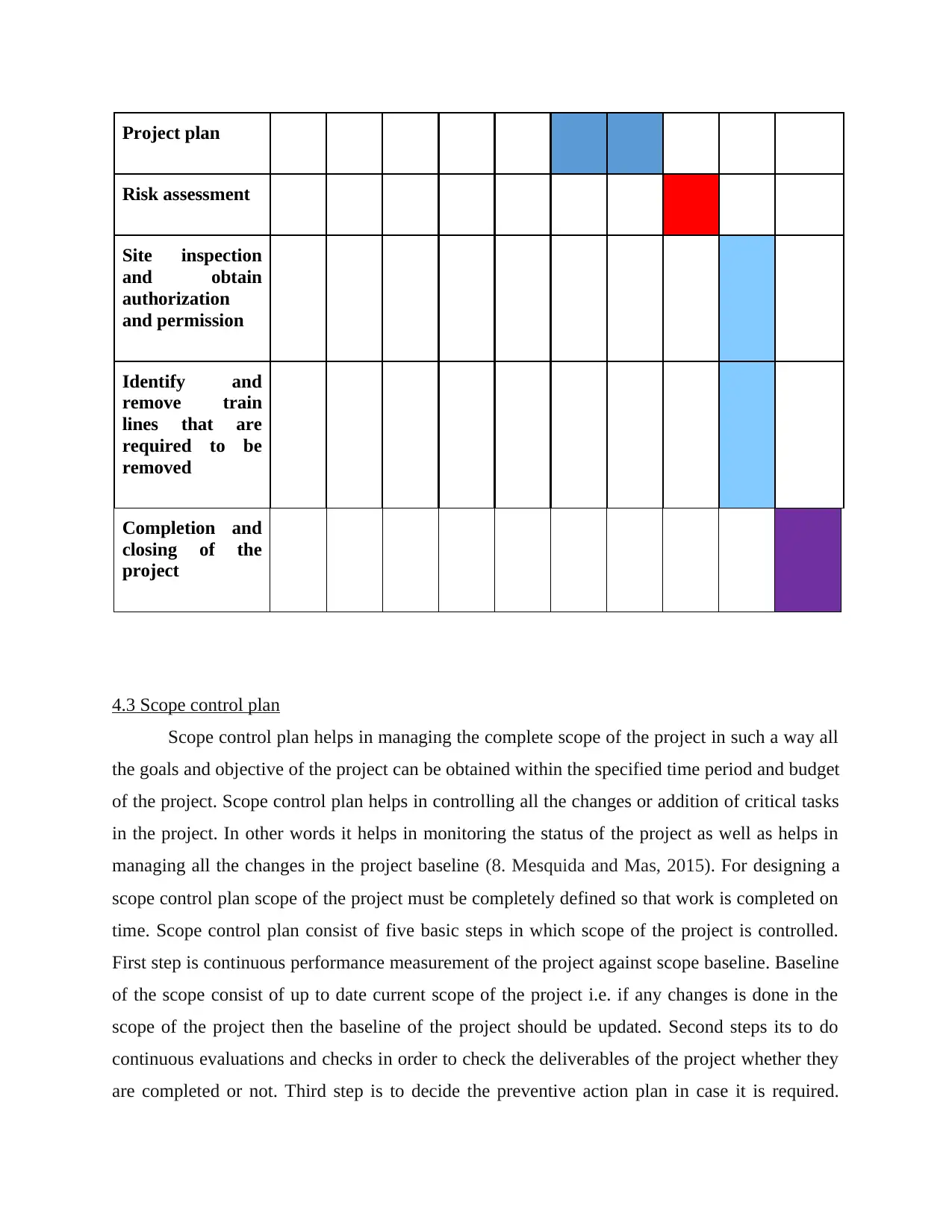
Project plan
Risk assessment
Site inspection
and obtain
authorization
and permission
Identify and
remove train
lines that are
required to be
removed
Completion and
closing of the
project
4.3 Scope control plan
Scope control plan helps in managing the complete scope of the project in such a way all
the goals and objective of the project can be obtained within the specified time period and budget
of the project. Scope control plan helps in controlling all the changes or addition of critical tasks
in the project. In other words it helps in monitoring the status of the project as well as helps in
managing all the changes in the project baseline (8. Mesquida and Mas, 2015). For designing a
scope control plan scope of the project must be completely defined so that work is completed on
time. Scope control plan consist of five basic steps in which scope of the project is controlled.
First step is continuous performance measurement of the project against scope baseline. Baseline
of the scope consist of up to date current scope of the project i.e. if any changes is done in the
scope of the project then the baseline of the project should be updated. Second steps its to do
continuous evaluations and checks in order to check the deliverables of the project whether they
are completed or not. Third step is to decide the preventive action plan in case it is required.
Risk assessment
Site inspection
and obtain
authorization
and permission
Identify and
remove train
lines that are
required to be
removed
Completion and
closing of the
project
4.3 Scope control plan
Scope control plan helps in managing the complete scope of the project in such a way all
the goals and objective of the project can be obtained within the specified time period and budget
of the project. Scope control plan helps in controlling all the changes or addition of critical tasks
in the project. In other words it helps in monitoring the status of the project as well as helps in
managing all the changes in the project baseline (8. Mesquida and Mas, 2015). For designing a
scope control plan scope of the project must be completely defined so that work is completed on
time. Scope control plan consist of five basic steps in which scope of the project is controlled.
First step is continuous performance measurement of the project against scope baseline. Baseline
of the scope consist of up to date current scope of the project i.e. if any changes is done in the
scope of the project then the baseline of the project should be updated. Second steps its to do
continuous evaluations and checks in order to check the deliverables of the project whether they
are completed or not. Third step is to decide the preventive action plan in case it is required.
⊘ This is a preview!⊘
Do you want full access?
Subscribe today to unlock all pages.

Trusted by 1+ million students worldwide
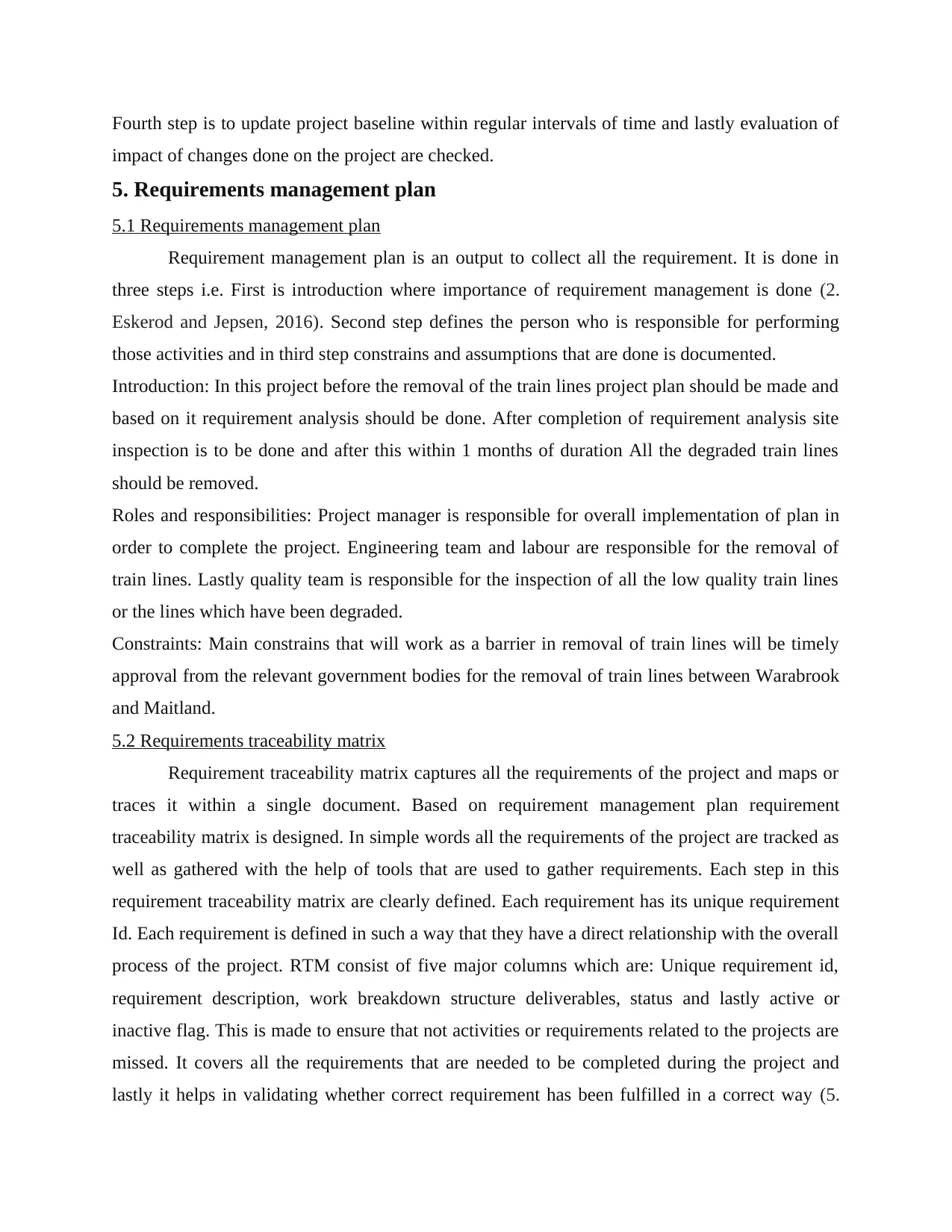
Fourth step is to update project baseline within regular intervals of time and lastly evaluation of
impact of changes done on the project are checked.
5. Requirements management plan
5.1 Requirements management plan
Requirement management plan is an output to collect all the requirement. It is done in
three steps i.e. First is introduction where importance of requirement management is done (2.
Eskerod and Jepsen, 2016). Second step defines the person who is responsible for performing
those activities and in third step constrains and assumptions that are done is documented.
Introduction: In this project before the removal of the train lines project plan should be made and
based on it requirement analysis should be done. After completion of requirement analysis site
inspection is to be done and after this within 1 months of duration All the degraded train lines
should be removed.
Roles and responsibilities: Project manager is responsible for overall implementation of plan in
order to complete the project. Engineering team and labour are responsible for the removal of
train lines. Lastly quality team is responsible for the inspection of all the low quality train lines
or the lines which have been degraded.
Constraints: Main constrains that will work as a barrier in removal of train lines will be timely
approval from the relevant government bodies for the removal of train lines between Warabrook
and Maitland.
5.2 Requirements traceability matrix
Requirement traceability matrix captures all the requirements of the project and maps or
traces it within a single document. Based on requirement management plan requirement
traceability matrix is designed. In simple words all the requirements of the project are tracked as
well as gathered with the help of tools that are used to gather requirements. Each step in this
requirement traceability matrix are clearly defined. Each requirement has its unique requirement
Id. Each requirement is defined in such a way that they have a direct relationship with the overall
process of the project. RTM consist of five major columns which are: Unique requirement id,
requirement description, work breakdown structure deliverables, status and lastly active or
inactive flag. This is made to ensure that not activities or requirements related to the projects are
missed. It covers all the requirements that are needed to be completed during the project and
lastly it helps in validating whether correct requirement has been fulfilled in a correct way (5.
impact of changes done on the project are checked.
5. Requirements management plan
5.1 Requirements management plan
Requirement management plan is an output to collect all the requirement. It is done in
three steps i.e. First is introduction where importance of requirement management is done (2.
Eskerod and Jepsen, 2016). Second step defines the person who is responsible for performing
those activities and in third step constrains and assumptions that are done is documented.
Introduction: In this project before the removal of the train lines project plan should be made and
based on it requirement analysis should be done. After completion of requirement analysis site
inspection is to be done and after this within 1 months of duration All the degraded train lines
should be removed.
Roles and responsibilities: Project manager is responsible for overall implementation of plan in
order to complete the project. Engineering team and labour are responsible for the removal of
train lines. Lastly quality team is responsible for the inspection of all the low quality train lines
or the lines which have been degraded.
Constraints: Main constrains that will work as a barrier in removal of train lines will be timely
approval from the relevant government bodies for the removal of train lines between Warabrook
and Maitland.
5.2 Requirements traceability matrix
Requirement traceability matrix captures all the requirements of the project and maps or
traces it within a single document. Based on requirement management plan requirement
traceability matrix is designed. In simple words all the requirements of the project are tracked as
well as gathered with the help of tools that are used to gather requirements. Each step in this
requirement traceability matrix are clearly defined. Each requirement has its unique requirement
Id. Each requirement is defined in such a way that they have a direct relationship with the overall
process of the project. RTM consist of five major columns which are: Unique requirement id,
requirement description, work breakdown structure deliverables, status and lastly active or
inactive flag. This is made to ensure that not activities or requirements related to the projects are
missed. It covers all the requirements that are needed to be completed during the project and
lastly it helps in validating whether correct requirement has been fulfilled in a correct way (5.
Paraphrase This Document
Need a fresh take? Get an instant paraphrase of this document with our AI Paraphraser
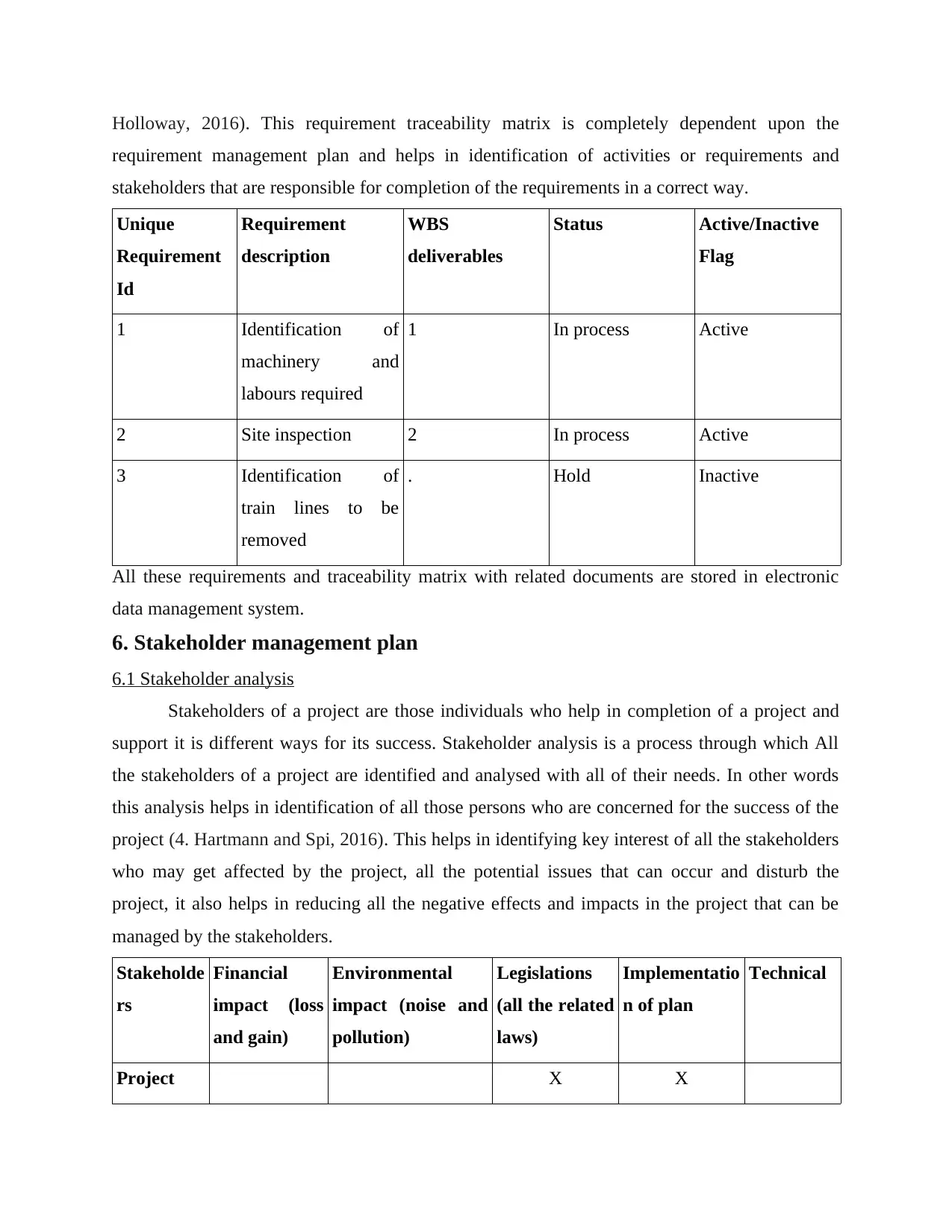
Holloway, 2016). This requirement traceability matrix is completely dependent upon the
requirement management plan and helps in identification of activities or requirements and
stakeholders that are responsible for completion of the requirements in a correct way.
Unique
Requirement
Id
Requirement
description
WBS
deliverables
Status Active/Inactive
Flag
1 Identification of
machinery and
labours required
1 In process Active
2 Site inspection 2 In process Active
3 Identification of
train lines to be
removed
. Hold Inactive
All these requirements and traceability matrix with related documents are stored in electronic
data management system.
6. Stakeholder management plan
6.1 Stakeholder analysis
Stakeholders of a project are those individuals who help in completion of a project and
support it is different ways for its success. Stakeholder analysis is a process through which All
the stakeholders of a project are identified and analysed with all of their needs. In other words
this analysis helps in identification of all those persons who are concerned for the success of the
project (4. Hartmann and Spi, 2016). This helps in identifying key interest of all the stakeholders
who may get affected by the project, all the potential issues that can occur and disturb the
project, it also helps in reducing all the negative effects and impacts in the project that can be
managed by the stakeholders.
Stakeholde
rs
Financial
impact (loss
and gain)
Environmental
impact (noise and
pollution)
Legislations
(all the related
laws)
Implementatio
n of plan
Technical
Project X X
requirement management plan and helps in identification of activities or requirements and
stakeholders that are responsible for completion of the requirements in a correct way.
Unique
Requirement
Id
Requirement
description
WBS
deliverables
Status Active/Inactive
Flag
1 Identification of
machinery and
labours required
1 In process Active
2 Site inspection 2 In process Active
3 Identification of
train lines to be
removed
. Hold Inactive
All these requirements and traceability matrix with related documents are stored in electronic
data management system.
6. Stakeholder management plan
6.1 Stakeholder analysis
Stakeholders of a project are those individuals who help in completion of a project and
support it is different ways for its success. Stakeholder analysis is a process through which All
the stakeholders of a project are identified and analysed with all of their needs. In other words
this analysis helps in identification of all those persons who are concerned for the success of the
project (4. Hartmann and Spi, 2016). This helps in identifying key interest of all the stakeholders
who may get affected by the project, all the potential issues that can occur and disturb the
project, it also helps in reducing all the negative effects and impacts in the project that can be
managed by the stakeholders.
Stakeholde
rs
Financial
impact (loss
and gain)
Environmental
impact (noise and
pollution)
Legislations
(all the related
laws)
Implementatio
n of plan
Technical
Project X X
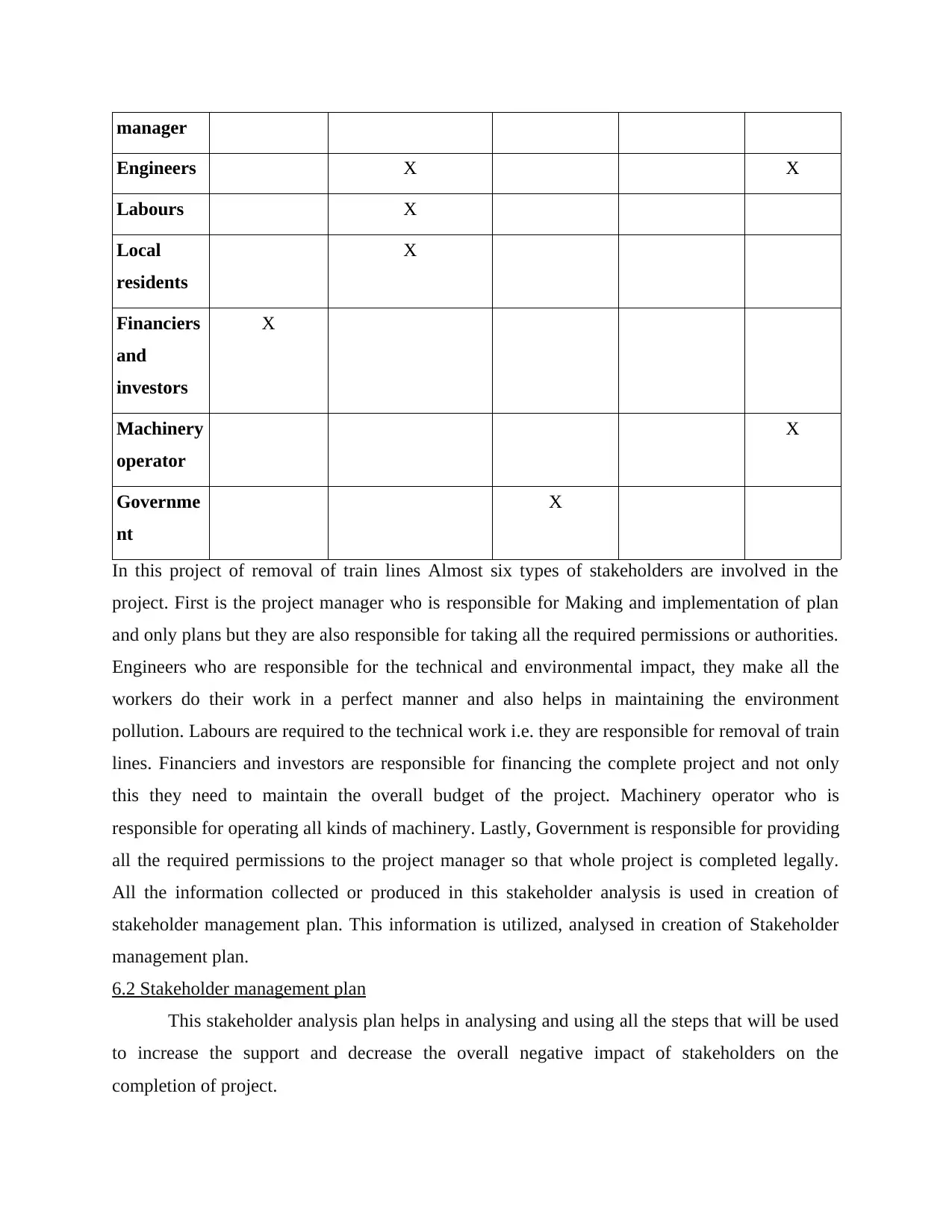
manager
Engineers X X
Labours X
Local
residents
X
Financiers
and
investors
X
Machinery
operator
X
Governme
nt
X
In this project of removal of train lines Almost six types of stakeholders are involved in the
project. First is the project manager who is responsible for Making and implementation of plan
and only plans but they are also responsible for taking all the required permissions or authorities.
Engineers who are responsible for the technical and environmental impact, they make all the
workers do their work in a perfect manner and also helps in maintaining the environment
pollution. Labours are required to the technical work i.e. they are responsible for removal of train
lines. Financiers and investors are responsible for financing the complete project and not only
this they need to maintain the overall budget of the project. Machinery operator who is
responsible for operating all kinds of machinery. Lastly, Government is responsible for providing
all the required permissions to the project manager so that whole project is completed legally.
All the information collected or produced in this stakeholder analysis is used in creation of
stakeholder management plan. This information is utilized, analysed in creation of Stakeholder
management plan.
6.2 Stakeholder management plan
This stakeholder analysis plan helps in analysing and using all the steps that will be used
to increase the support and decrease the overall negative impact of stakeholders on the
completion of project.
Engineers X X
Labours X
Local
residents
X
Financiers
and
investors
X
Machinery
operator
X
Governme
nt
X
In this project of removal of train lines Almost six types of stakeholders are involved in the
project. First is the project manager who is responsible for Making and implementation of plan
and only plans but they are also responsible for taking all the required permissions or authorities.
Engineers who are responsible for the technical and environmental impact, they make all the
workers do their work in a perfect manner and also helps in maintaining the environment
pollution. Labours are required to the technical work i.e. they are responsible for removal of train
lines. Financiers and investors are responsible for financing the complete project and not only
this they need to maintain the overall budget of the project. Machinery operator who is
responsible for operating all kinds of machinery. Lastly, Government is responsible for providing
all the required permissions to the project manager so that whole project is completed legally.
All the information collected or produced in this stakeholder analysis is used in creation of
stakeholder management plan. This information is utilized, analysed in creation of Stakeholder
management plan.
6.2 Stakeholder management plan
This stakeholder analysis plan helps in analysing and using all the steps that will be used
to increase the support and decrease the overall negative impact of stakeholders on the
completion of project.
⊘ This is a preview!⊘
Do you want full access?
Subscribe today to unlock all pages.

Trusted by 1+ million students worldwide
1 out of 16
Related Documents
Your All-in-One AI-Powered Toolkit for Academic Success.
+13062052269
info@desklib.com
Available 24*7 on WhatsApp / Email
![[object Object]](/_next/static/media/star-bottom.7253800d.svg)
Unlock your academic potential
Copyright © 2020–2025 A2Z Services. All Rights Reserved. Developed and managed by ZUCOL.





